Fue no shiratama / Undying Pearl / Eternal Heart (Hiroshi Shimizu, 1929)
So far as i can determine, Fue no shiratama is Hiroshi Shimizu's oldest surviving film.  According to the JMDB, however, this was actually the fifty-sixth film he directed. So not surprisingly, this is the work of a film maker who had already mastered his craft. While the story the film tells might appear rather conventional, visual presentation is fairly striking.
According to the JMDB, however, this was actually the fifty-sixth film he directed. So not surprisingly, this is the work of a film maker who had already mastered his craft. While the story the film tells might appear rather conventional, visual presentation is fairly striking.
The central character here is Toshie (played by Emiko Yagumo, who also starred in a number of early Ozu films), a young woman who works as a secretary-typist, but wears a kimono and is relatively reserved and old-fashioned. She has fallen in love with Shozo Narita (Minoru Takada),
(played by Emiko Yagumo, who also starred in a number of early Ozu films), a young woman who works as a secretary-typist, but wears a kimono and is relatively reserved and old-fashioned. She has fallen in love with Shozo Narita (Minoru Takada), 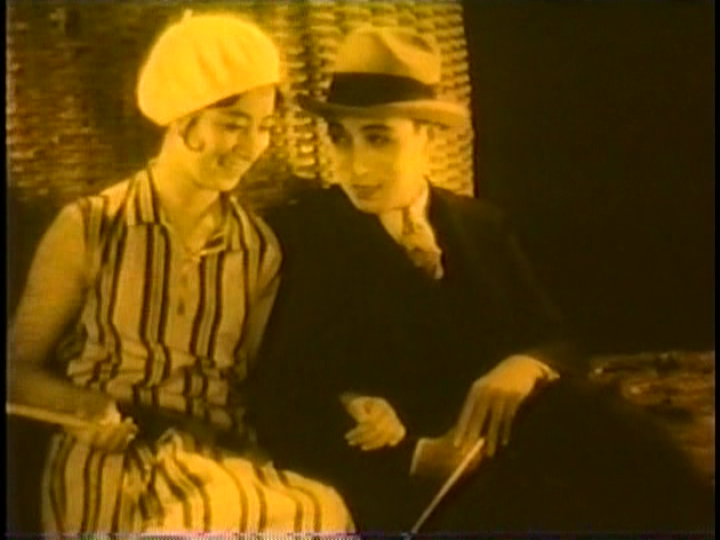 a young man she has met through her work. Alas, once Narita meets Toshie's vivacious sister Reiko (Michiko Oikawa), Toshie is relegated to the status of little more than a friendly confidante. Toshie selflessly hides her true feelings, and promotes a marriage between Narita and Reiko.
a young man she has met through her work. Alas, once Narita meets Toshie's vivacious sister Reiko (Michiko Oikawa), Toshie is relegated to the status of little more than a friendly confidante. Toshie selflessly hides her true feelings, and promotes a marriage between Narita and Reiko.  But Reiko is so enamored of partying and nightclubbing, that she continues to pursue these activities even after her marriage. Meanwhile Toshie is being courted by her widower boss Mr. Katayama (Jun Arai), who is looking for a mother for his three children.
But Reiko is so enamored of partying and nightclubbing, that she continues to pursue these activities even after her marriage. Meanwhile Toshie is being courted by her widower boss Mr. Katayama (Jun Arai), who is looking for a mother for his three children. 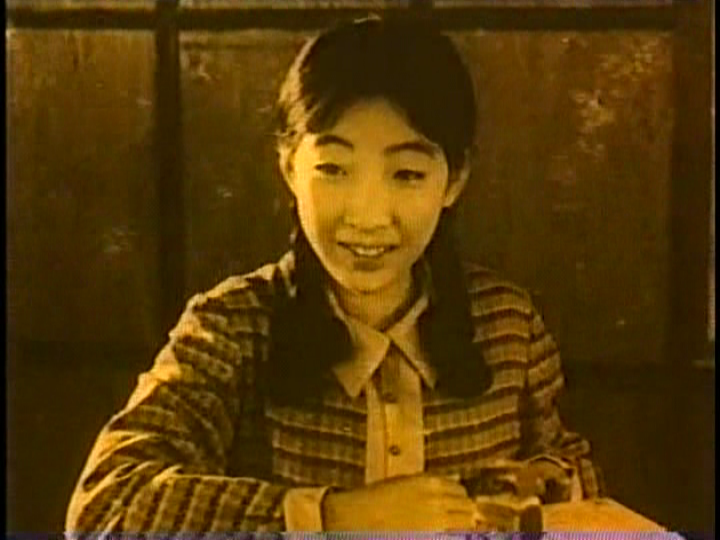 When Toshie visits the Katayamas at their country home, she finds that the children (and their teen-aged girl cousins) are very "lively" and not especially polite. Whether malicious or not, the young people's behavior mortifies Toshie -- and Mr. Katayama doesn't do much to shield her.
When Toshie visits the Katayamas at their country home, she finds that the children (and their teen-aged girl cousins) are very "lively" and not especially polite. Whether malicious or not, the young people's behavior mortifies Toshie -- and Mr. Katayama doesn't do much to shield her.
As Toshie dispiritedly returns home,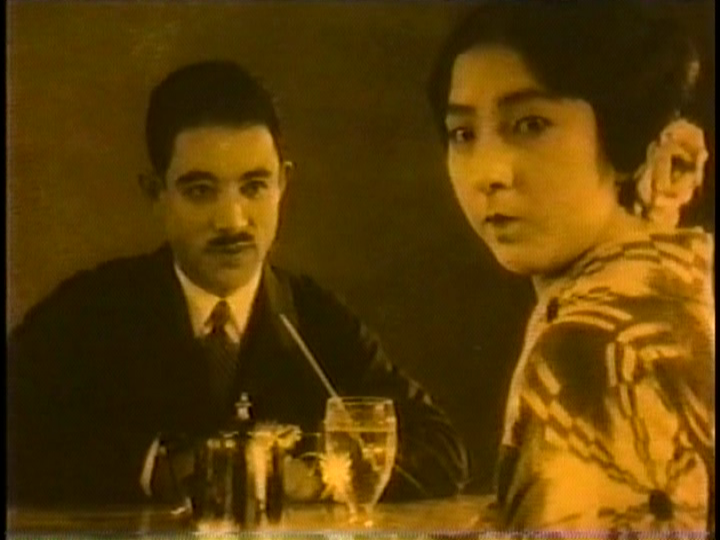 Toshie encounters Narita, who tells her of the increasingly dismaying state of his relationship with Reiko. Toshie tracks Reiko down at a dance club (where she is being attended by a rich, middle-aged swell) and insists she return home. Reiko complies, but once home, she tells both Toshie and her husband that she refuses to be tied down -- and then leaves to return to her party.
Toshie encounters Narita, who tells her of the increasingly dismaying state of his relationship with Reiko. Toshie tracks Reiko down at a dance club (where she is being attended by a rich, middle-aged swell) and insists she return home. Reiko complies, but once home, she tells both Toshie and her husband that she refuses to be tied down -- and then leaves to return to her party.
The film then jumps forward an unspecified amount of time -- and we see Narita telling Toshie that he is planning to leave Japan and travel to America (alone). He asks about her situation with Mr. Katayama, and she assures him that he is being very kind and patient.
and we see Narita telling Toshie that he is planning to leave Japan and travel to America (alone). He asks about her situation with Mr. Katayama, and she assures him that he is being very kind and patient.  It is unclear whether she has managed to establish a comfortable relationship with the children at last -- or that she she will actually wind up marrying him. But Narita, still unaware of Toshie's feelings for him, is satisfied by her rather circumspect answer.
It is unclear whether she has managed to establish a comfortable relationship with the children at last -- or that she she will actually wind up marrying him. But Narita, still unaware of Toshie's feelings for him, is satisfied by her rather circumspect answer. 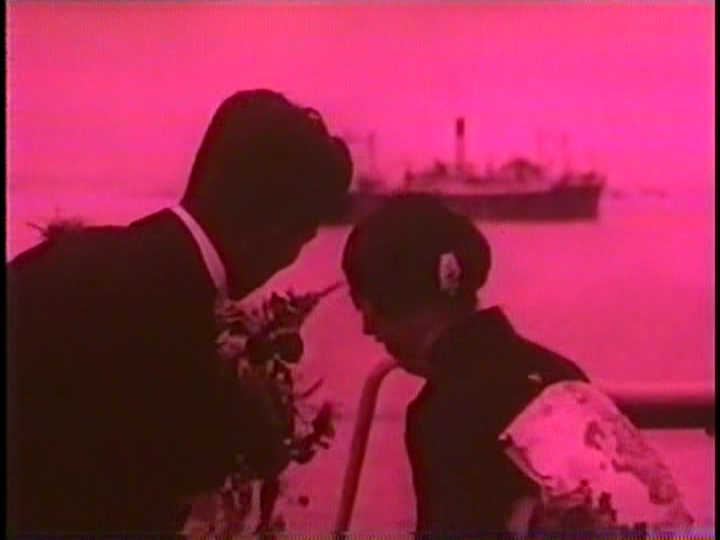 The film ends with Toshie, Katayama and various friends of Narita, seeing him off as he boards his ship. Reiko is, of course, conspicuous by her absence. As the ship departs, intertitles present Toshie's lament over the loss of the only true love of her life.
The film ends with Toshie, Katayama and various friends of Narita, seeing him off as he boards his ship. Reiko is, of course, conspicuous by her absence. As the ship departs, intertitles present Toshie's lament over the loss of the only true love of her life.
Although I said above that this story might seem conventional, perhaps it wasn't --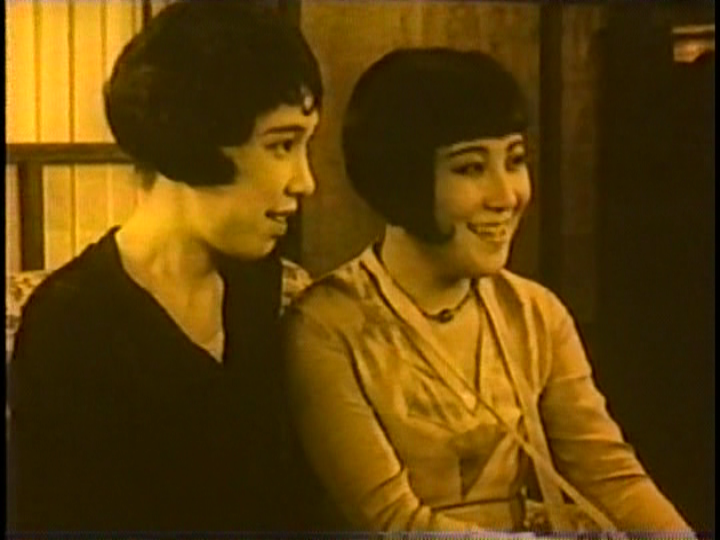 not back when it was made. Most obviously, the younger sister Reiko is the epitome of a moga (modern girl), which was a new phenomenon that seems to have gotten its start during the rebuilding process following the Kanto Earthquake of 1923. Moga were early adopters of up-to-date western clothing -- and (to some extent) habits.
not back when it was made. Most obviously, the younger sister Reiko is the epitome of a moga (modern girl), which was a new phenomenon that seems to have gotten its start during the rebuilding process following the Kanto Earthquake of 1923. Moga were early adopters of up-to-date western clothing -- and (to some extent) habits.
Barbara Sato's New Japanese Woman (Duke University Press, 2003), which I just finished reading, pointed out something that I had not previously realized. The serious working woman (of which Toshie was a type) was just as much the product of modernity as the moga. Prior to the 20s, young middle-class women usually worked only due to dire necessity,
which I just finished reading, pointed out something that I had not previously realized. The serious working woman (of which Toshie was a type) was just as much the product of modernity as the moga. Prior to the 20s, young middle-class women usually worked only due to dire necessity,  but the nunber of educated working women rose steadily and fairly rapidly throughout the '20s and '30s. Sato also points out that, by contrast, real life moga were were comparatively rare. A survey conducted in Tokyo's main shopping area in 1925 found only one woman in a hundred to be wearing western clothing.
but the nunber of educated working women rose steadily and fairly rapidly throughout the '20s and '30s. Sato also points out that, by contrast, real life moga were were comparatively rare. A survey conducted in Tokyo's main shopping area in 1925 found only one woman in a hundred to be wearing western clothing. 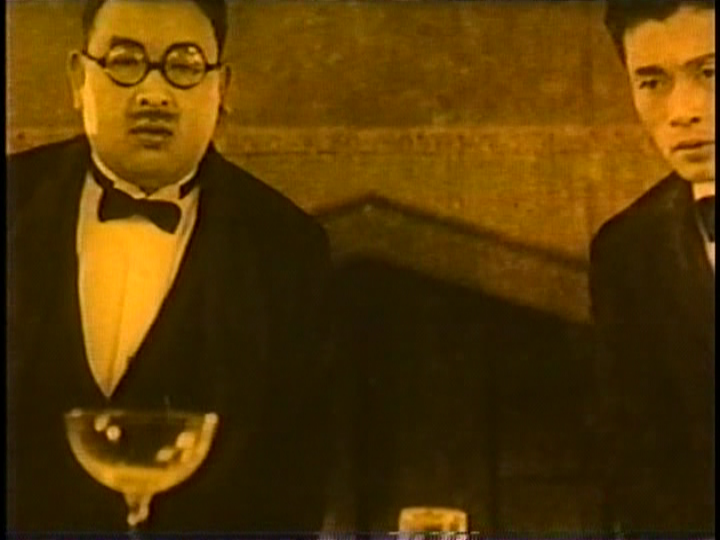 Whatever their numbers, it was moga who were the main focus of cultural disapproval. Traditionalists viewed them as decadent and threatening. Leftists, on the other hand, primarily disapproved of their vapidity and consumerist orientation.
Whatever their numbers, it was moga who were the main focus of cultural disapproval. Traditionalists viewed them as decadent and threatening. Leftists, on the other hand, primarily disapproved of their vapidity and consumerist orientation.
Most Japanese movies of the 1920s are now lost to the ravages of time (and war),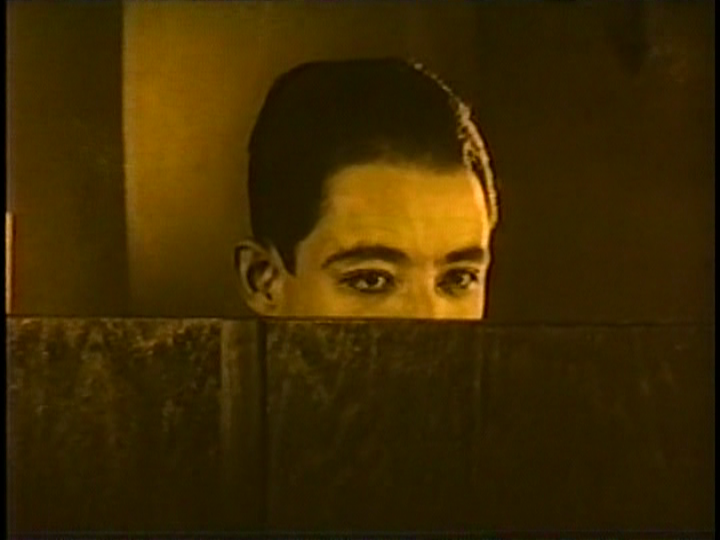 so one may not be able to pinpoint the first cinematic depiction of a moga. Nonetheless, Shimizu's anti-heroine here is probably one of the earliest. Similarly, this must have been one of the earliest Japanese films that was centered about the contrast (or even opposition)
so one may not be able to pinpoint the first cinematic depiction of a moga. Nonetheless, Shimizu's anti-heroine here is probably one of the earliest. Similarly, this must have been one of the earliest Japanese films that was centered about the contrast (or even opposition) 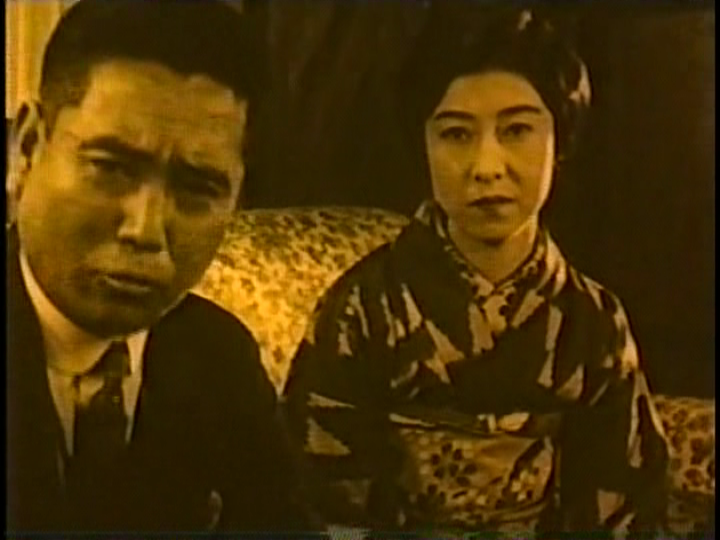 between a somewhat more traditional young woman and a more modern-appearing (and less inhibited) one. This motif would show up with regularity throughout the 30s and still echoed in the 50s (e.g., Ozu's Munekata Sisters, Naruse's Ginza Cosmetics) and even to the present in somewhat attenuated form (e.g., Ôtani's Nana).
between a somewhat more traditional young woman and a more modern-appearing (and less inhibited) one. This motif would show up with regularity throughout the 30s and still echoed in the 50s (e.g., Ozu's Munekata Sisters, Naruse's Ginza Cosmetics) and even to the present in somewhat attenuated form (e.g., Ôtani's Nana).
In terms of visual style,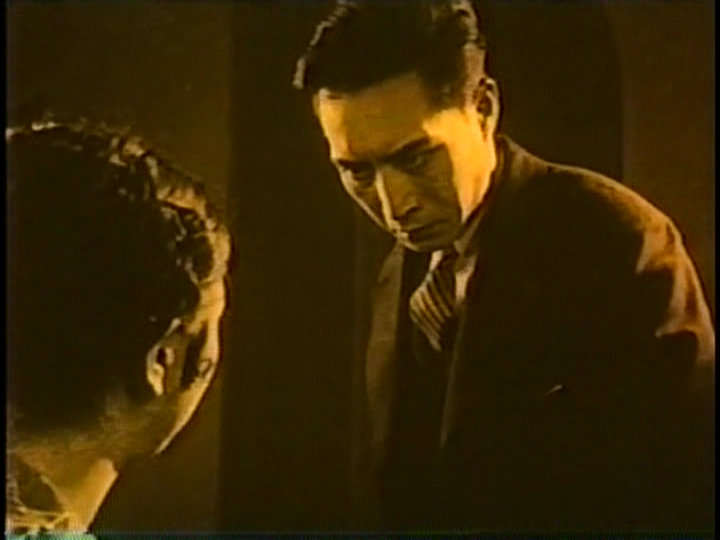 Fue no shiratama is very heterogeneous. Montage, piecemeal decoupage, moderately long shots and even some florid shots (with an agile camera) reminiscent of contemporary chambara films. The most impressive camera work occurs at the climax of the film, the final confrontation of the two sisters. In a long, carefully choreographed (for actresses and camera alike) take, Toshie tries to restrain Reiko.
Fue no shiratama is very heterogeneous. Montage, piecemeal decoupage, moderately long shots and even some florid shots (with an agile camera) reminiscent of contemporary chambara films. The most impressive camera work occurs at the climax of the film, the final confrontation of the two sisters. In a long, carefully choreographed (for actresses and camera alike) take, Toshie tries to restrain Reiko.  At the high point of their interaction, Shimizu switches to a shared closeup, in which the two are for a moment virtually nose to nose -- and then Reiko slides past. Shimizu next cuts to a medium shot for the parting of the sisters. While the rest of the film is generally less dynamic than this, it is uniformly visually imaginative.
At the high point of their interaction, Shimizu switches to a shared closeup, in which the two are for a moment virtually nose to nose -- and then Reiko slides past. Shimizu next cuts to a medium shot for the parting of the sisters. While the rest of the film is generally less dynamic than this, it is uniformly visually imaginative.
About the name --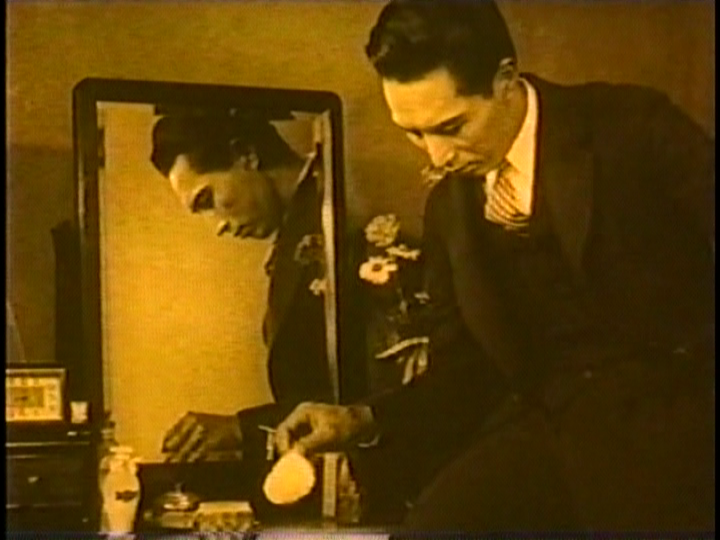 as best I can tell, "fue no" means "indestructible" and shiratama means "white jewel". While none of my Japanese dictionaries helped pinpoint which white jewel the title named, a Chinese dictionary (belonging to one of my children) translated the kanji as "pearl".
as best I can tell, "fue no" means "indestructible" and shiratama means "white jewel". While none of my Japanese dictionaries helped pinpoint which white jewel the title named, a Chinese dictionary (belonging to one of my children) translated the kanji as "pearl". 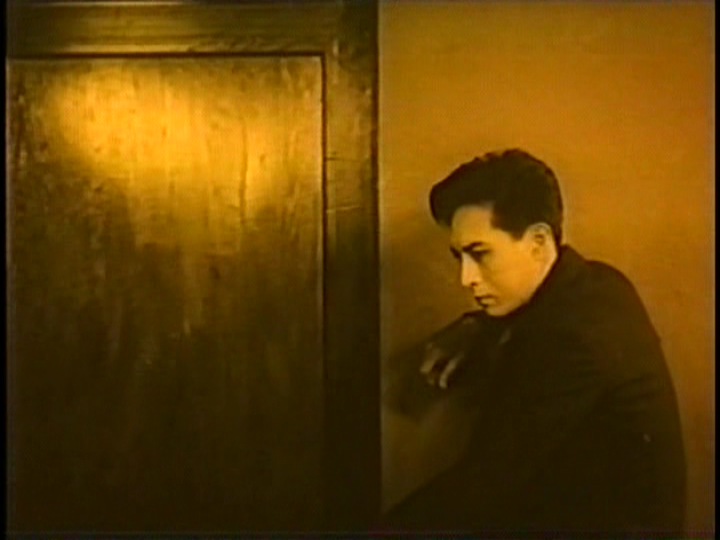 So one assumes that the kanji used for "pearl" in the Japanese title was intended to evoke some antique poetical work. Once again, we find an important Japanese film burdened by what would seem to be an inaccurate (and, in this case, a bit nonsensical) English name.
So one assumes that the kanji used for "pearl" in the Japanese title was intended to evoke some antique poetical work. Once again, we find an important Japanese film burdened by what would seem to be an inaccurate (and, in this case, a bit nonsensical) English name.
It is tantalizing to see any of the comparatively few remaining Japanese films of the '20s.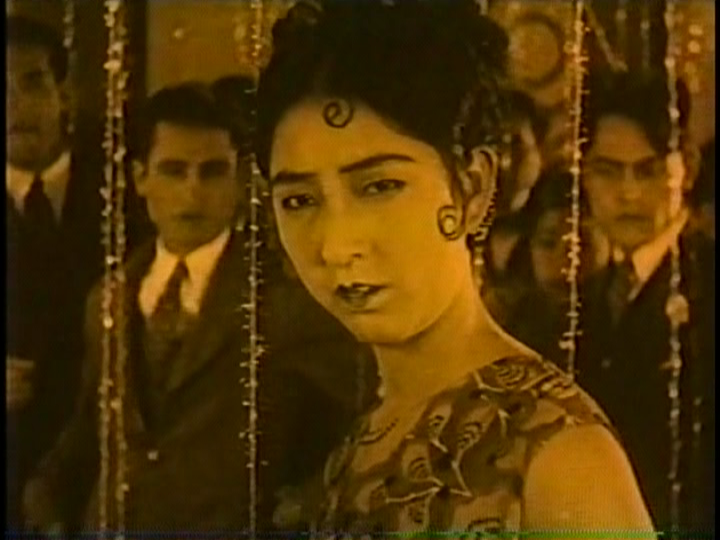 These offer a window into a period in Japanese cinema that that has almost vanished. One can't help wondering just how many great masterpieces have been irretrievably lost. One can only hope that some DVD comany will adopt this early Shimizu masterpiece and make it available to Western viewers.
These offer a window into a period in Japanese cinema that that has almost vanished. One can't help wondering just how many great masterpieces have been irretrievably lost. One can only hope that some DVD comany will adopt this early Shimizu masterpiece and make it available to Western viewers.
 According to the JMDB, however, this was actually the fifty-sixth film he directed. So not surprisingly, this is the work of a film maker who had already mastered his craft. While the story the film tells might appear rather conventional, visual presentation is fairly striking.
According to the JMDB, however, this was actually the fifty-sixth film he directed. So not surprisingly, this is the work of a film maker who had already mastered his craft. While the story the film tells might appear rather conventional, visual presentation is fairly striking.The central character here is Toshie
 (played by Emiko Yagumo, who also starred in a number of early Ozu films), a young woman who works as a secretary-typist, but wears a kimono and is relatively reserved and old-fashioned. She has fallen in love with Shozo Narita (Minoru Takada),
(played by Emiko Yagumo, who also starred in a number of early Ozu films), a young woman who works as a secretary-typist, but wears a kimono and is relatively reserved and old-fashioned. She has fallen in love with Shozo Narita (Minoru Takada),  a young man she has met through her work. Alas, once Narita meets Toshie's vivacious sister Reiko (Michiko Oikawa), Toshie is relegated to the status of little more than a friendly confidante. Toshie selflessly hides her true feelings, and promotes a marriage between Narita and Reiko.
a young man she has met through her work. Alas, once Narita meets Toshie's vivacious sister Reiko (Michiko Oikawa), Toshie is relegated to the status of little more than a friendly confidante. Toshie selflessly hides her true feelings, and promotes a marriage between Narita and Reiko.  But Reiko is so enamored of partying and nightclubbing, that she continues to pursue these activities even after her marriage. Meanwhile Toshie is being courted by her widower boss Mr. Katayama (Jun Arai), who is looking for a mother for his three children.
But Reiko is so enamored of partying and nightclubbing, that she continues to pursue these activities even after her marriage. Meanwhile Toshie is being courted by her widower boss Mr. Katayama (Jun Arai), who is looking for a mother for his three children.  When Toshie visits the Katayamas at their country home, she finds that the children (and their teen-aged girl cousins) are very "lively" and not especially polite. Whether malicious or not, the young people's behavior mortifies Toshie -- and Mr. Katayama doesn't do much to shield her.
When Toshie visits the Katayamas at their country home, she finds that the children (and their teen-aged girl cousins) are very "lively" and not especially polite. Whether malicious or not, the young people's behavior mortifies Toshie -- and Mr. Katayama doesn't do much to shield her.As Toshie dispiritedly returns home,
 Toshie encounters Narita, who tells her of the increasingly dismaying state of his relationship with Reiko. Toshie tracks Reiko down at a dance club (where she is being attended by a rich, middle-aged swell) and insists she return home. Reiko complies, but once home, she tells both Toshie and her husband that she refuses to be tied down -- and then leaves to return to her party.
Toshie encounters Narita, who tells her of the increasingly dismaying state of his relationship with Reiko. Toshie tracks Reiko down at a dance club (where she is being attended by a rich, middle-aged swell) and insists she return home. Reiko complies, but once home, she tells both Toshie and her husband that she refuses to be tied down -- and then leaves to return to her party.The film then jumps forward an unspecified amount of time --
 and we see Narita telling Toshie that he is planning to leave Japan and travel to America (alone). He asks about her situation with Mr. Katayama, and she assures him that he is being very kind and patient.
and we see Narita telling Toshie that he is planning to leave Japan and travel to America (alone). He asks about her situation with Mr. Katayama, and she assures him that he is being very kind and patient.  It is unclear whether she has managed to establish a comfortable relationship with the children at last -- or that she she will actually wind up marrying him. But Narita, still unaware of Toshie's feelings for him, is satisfied by her rather circumspect answer.
It is unclear whether she has managed to establish a comfortable relationship with the children at last -- or that she she will actually wind up marrying him. But Narita, still unaware of Toshie's feelings for him, is satisfied by her rather circumspect answer.  The film ends with Toshie, Katayama and various friends of Narita, seeing him off as he boards his ship. Reiko is, of course, conspicuous by her absence. As the ship departs, intertitles present Toshie's lament over the loss of the only true love of her life.
The film ends with Toshie, Katayama and various friends of Narita, seeing him off as he boards his ship. Reiko is, of course, conspicuous by her absence. As the ship departs, intertitles present Toshie's lament over the loss of the only true love of her life.Although I said above that this story might seem conventional, perhaps it wasn't --
 not back when it was made. Most obviously, the younger sister Reiko is the epitome of a moga (modern girl), which was a new phenomenon that seems to have gotten its start during the rebuilding process following the Kanto Earthquake of 1923. Moga were early adopters of up-to-date western clothing -- and (to some extent) habits.
not back when it was made. Most obviously, the younger sister Reiko is the epitome of a moga (modern girl), which was a new phenomenon that seems to have gotten its start during the rebuilding process following the Kanto Earthquake of 1923. Moga were early adopters of up-to-date western clothing -- and (to some extent) habits.Barbara Sato's New Japanese Woman (Duke University Press, 2003),
 which I just finished reading, pointed out something that I had not previously realized. The serious working woman (of which Toshie was a type) was just as much the product of modernity as the moga. Prior to the 20s, young middle-class women usually worked only due to dire necessity,
which I just finished reading, pointed out something that I had not previously realized. The serious working woman (of which Toshie was a type) was just as much the product of modernity as the moga. Prior to the 20s, young middle-class women usually worked only due to dire necessity,  but the nunber of educated working women rose steadily and fairly rapidly throughout the '20s and '30s. Sato also points out that, by contrast, real life moga were were comparatively rare. A survey conducted in Tokyo's main shopping area in 1925 found only one woman in a hundred to be wearing western clothing.
but the nunber of educated working women rose steadily and fairly rapidly throughout the '20s and '30s. Sato also points out that, by contrast, real life moga were were comparatively rare. A survey conducted in Tokyo's main shopping area in 1925 found only one woman in a hundred to be wearing western clothing.  Whatever their numbers, it was moga who were the main focus of cultural disapproval. Traditionalists viewed them as decadent and threatening. Leftists, on the other hand, primarily disapproved of their vapidity and consumerist orientation.
Whatever their numbers, it was moga who were the main focus of cultural disapproval. Traditionalists viewed them as decadent and threatening. Leftists, on the other hand, primarily disapproved of their vapidity and consumerist orientation.Most Japanese movies of the 1920s are now lost to the ravages of time (and war),
 so one may not be able to pinpoint the first cinematic depiction of a moga. Nonetheless, Shimizu's anti-heroine here is probably one of the earliest. Similarly, this must have been one of the earliest Japanese films that was centered about the contrast (or even opposition)
so one may not be able to pinpoint the first cinematic depiction of a moga. Nonetheless, Shimizu's anti-heroine here is probably one of the earliest. Similarly, this must have been one of the earliest Japanese films that was centered about the contrast (or even opposition)  between a somewhat more traditional young woman and a more modern-appearing (and less inhibited) one. This motif would show up with regularity throughout the 30s and still echoed in the 50s (e.g., Ozu's Munekata Sisters, Naruse's Ginza Cosmetics) and even to the present in somewhat attenuated form (e.g., Ôtani's Nana).
between a somewhat more traditional young woman and a more modern-appearing (and less inhibited) one. This motif would show up with regularity throughout the 30s and still echoed in the 50s (e.g., Ozu's Munekata Sisters, Naruse's Ginza Cosmetics) and even to the present in somewhat attenuated form (e.g., Ôtani's Nana).In terms of visual style,
 Fue no shiratama is very heterogeneous. Montage, piecemeal decoupage, moderately long shots and even some florid shots (with an agile camera) reminiscent of contemporary chambara films. The most impressive camera work occurs at the climax of the film, the final confrontation of the two sisters. In a long, carefully choreographed (for actresses and camera alike) take, Toshie tries to restrain Reiko.
Fue no shiratama is very heterogeneous. Montage, piecemeal decoupage, moderately long shots and even some florid shots (with an agile camera) reminiscent of contemporary chambara films. The most impressive camera work occurs at the climax of the film, the final confrontation of the two sisters. In a long, carefully choreographed (for actresses and camera alike) take, Toshie tries to restrain Reiko.  At the high point of their interaction, Shimizu switches to a shared closeup, in which the two are for a moment virtually nose to nose -- and then Reiko slides past. Shimizu next cuts to a medium shot for the parting of the sisters. While the rest of the film is generally less dynamic than this, it is uniformly visually imaginative.
At the high point of their interaction, Shimizu switches to a shared closeup, in which the two are for a moment virtually nose to nose -- and then Reiko slides past. Shimizu next cuts to a medium shot for the parting of the sisters. While the rest of the film is generally less dynamic than this, it is uniformly visually imaginative.About the name --
 as best I can tell, "fue no" means "indestructible" and shiratama means "white jewel". While none of my Japanese dictionaries helped pinpoint which white jewel the title named, a Chinese dictionary (belonging to one of my children) translated the kanji as "pearl".
as best I can tell, "fue no" means "indestructible" and shiratama means "white jewel". While none of my Japanese dictionaries helped pinpoint which white jewel the title named, a Chinese dictionary (belonging to one of my children) translated the kanji as "pearl".  So one assumes that the kanji used for "pearl" in the Japanese title was intended to evoke some antique poetical work. Once again, we find an important Japanese film burdened by what would seem to be an inaccurate (and, in this case, a bit nonsensical) English name.
So one assumes that the kanji used for "pearl" in the Japanese title was intended to evoke some antique poetical work. Once again, we find an important Japanese film burdened by what would seem to be an inaccurate (and, in this case, a bit nonsensical) English name.It is tantalizing to see any of the comparatively few remaining Japanese films of the '20s.
 These offer a window into a period in Japanese cinema that that has almost vanished. One can't help wondering just how many great masterpieces have been irretrievably lost. One can only hope that some DVD comany will adopt this early Shimizu masterpiece and make it available to Western viewers.
These offer a window into a period in Japanese cinema that that has almost vanished. One can't help wondering just how many great masterpieces have been irretrievably lost. One can only hope that some DVD comany will adopt this early Shimizu masterpiece and make it available to Western viewers.
Comments